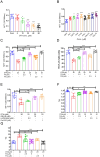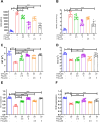Through its genoprotective, mitochondrial bioenergetic modulation, and antioxidant effects, Fucoxanthin and its metabolite minimize Ochratoxin A-induced nephrotoxicity in HK-2 human kidney cells
- PMID: 40652198
- PMCID: PMC12255067
- DOI: 10.1186/s12882-025-04276-z
Through its genoprotective, mitochondrial bioenergetic modulation, and antioxidant effects, Fucoxanthin and its metabolite minimize Ochratoxin A-induced nephrotoxicity in HK-2 human kidney cells
Abstract
Background: Ochratoxin A (OTA) is a mycotoxin with reported multiorgan toxicity, especially kidney toxicity. Fucoxanthin (FX) and its hydrolyzed metabolite Fucoxanthinol (FXL) have reno-protective antioxidant and anti-inflammatory properties. This study evaluates the nephroprotective effects of FX and FLX on OTA-induced renal cytotoxicity using the HK-2 cell line.
Methods: Molecular docking was used to study the binding affinities with the main proteins of the studied pathways. Various in-vitro assays were used to test the hypothesis, including MTT, mitochondrial bioenergetics, oxidative stress, and apoptosis biomarkers.
Results: Docking revealed binding affinities of the tested chemicals with mitochondria, oxidative stress, and apoptosis. Data showed that OTA has a dose-dependent cytotoxic effect on HK-2 cells. Notably, FX and FXL improved cell viability. A significant deregulation of normal cellular pathways including genotoxicity (DNA damage percentage), mitochondrial bioenergetics disruption (PDH, α-KG, MCI and MCIII complexes activities, ATP levels and mitochondrial membrane potential), downregulation of some mitochondrial genes (ND1, ND5, CO-1 and ATP6/8) expression, mitophagy inhibition (PARK1 and parkin), Oxidative stress induction (ROS and TBARS), oxidative stress genes downregulation (HO-1 and Nrf2), antioxidant enzymatic activity reduction (ROS and CAT), and apoptotic mediator markers elevation (Caspases- 3, 8 and 9, and Bax/Bcl-2 ratio) were observed in OTA mono-treated cells compared to untreated control cells. All parameters were markedly normalized by combining FX or FLX with OTA, providing more protection in FXL co-treated samples.
Conclusion: Our results suggest that FX and FXL may be effective novel therapies for treating OTA-induced nephrotoxicity in vitro.
Keywords: Cellular bioenergetics; Fucoxanthin; Fucoxanthinol; Mitochondria; Nephrotoxicity; Ochratoxin A; Oxidative stress.
© 2025. The Author(s).
Conflict of interest statement
Declarations. Ethics, consent to participate, and consent to publish: Not applicable. Competing interests: The authors declare no competing interests.
Figures






Similar articles
-
Fucoxanthin alleviates the cytotoxic effects of cadmium and lead on a human osteoblast cell line.Toxicol Res (Camb). 2024 Dec 19;13(6):tfae218. doi: 10.1093/toxres/tfae218. eCollection 2024 Dec. Toxicol Res (Camb). 2024. PMID: 39712643
-
Ochratoxin A-induced mitochondrial pathway apoptosis and ferroptosis by promoting glycolysis.Apoptosis. 2025 Jun;30(5-6):1440-1452. doi: 10.1007/s10495-025-02109-w. Epub 2025 Apr 1. Apoptosis. 2025. PMID: 40167953
-
Tartary Buckwheat Peptides Prevent Oxidative Damage in Differentiated SOL8 Cells via a Mitochondria-Mediated Apoptosis Pathway.Nutrients. 2025 Jul 2;17(13):2204. doi: 10.3390/nu17132204. Nutrients. 2025. PMID: 40647308 Free PMC article.
-
Management of urinary stones by experts in stone disease (ESD 2025).Arch Ital Urol Androl. 2025 Jun 30;97(2):14085. doi: 10.4081/aiua.2025.14085. Epub 2025 Jun 30. Arch Ital Urol Androl. 2025. PMID: 40583613 Review.
-
Antioxidants for female subfertility.Cochrane Database Syst Rev. 2013 Aug 5;(8):CD007807. doi: 10.1002/14651858.CD007807.pub2. Cochrane Database Syst Rev. 2013. Update in: Cochrane Database Syst Rev. 2017 Jul 28;7:CD007807. doi: 10.1002/14651858.CD007807.pub3. PMID: 23913583 Updated.
Cited by
-
Redefining Chemoresistance: Natural Bioactives as Molecular Modulators at the Cancer-Tumor Microenvironment Interface.Int J Mol Sci. 2025 Aug 20;26(16):8037. doi: 10.3390/ijms26168037. Int J Mol Sci. 2025. PMID: 40869364 Free PMC article. Review.
References
-
- Eskola M, et al. Towards a dietary-exposome assessment of chemicals in food: an update on the chronic health risks for the European consumer. Crit Rev Food Sci Nutr. 2020;60(11):1890–911. - PubMed
-
- Zhang Q, et al. Formation of Furan from Linoleic acid thermal Oxidation:(E, E)-2, 4-Decadienal as a Critical Intermediate Product. J Agric Food Chem. 2024;72(8):4384–92. - PubMed
MeSH terms
Substances
Grants and funding
LinkOut - more resources
Full Text Sources
Medical
Research Materials
Miscellaneous

